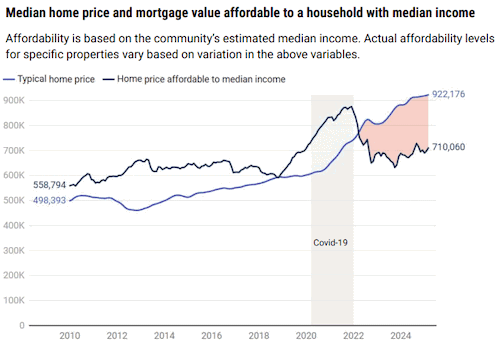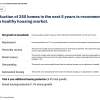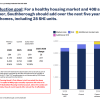Above: In an updated analysis of Southborough’s housing situation, the Town found a startling shift in home prices versus median incomes for the “area” during the past five years. (image cropped from 2025 – 2030 HPP)
Last week, the Planning Board and Select Board voted to approve the Town’s updated 5 year Housing Production Plan. The plan is one element for the Town to maintain “safe harbor” against unwanted new 40B housing projects.
The HPP identifies the town’s “affordable housing needs” and recommends strategies for meeting them. Those tactics include potential zoning changes, like lifting the nearly maxed out cap on age 55+ housing developments.
In their discussion with the board of the Affordable Housing Trust, Planning members agreed to work with them on bylaw changes prompted by the findings. Also worth highlighting from AHT’s findings are the fiscal challenges facing current residents “cost-burdened” by their Southborough homes and markedly increased financial barriers for moving into town.
Here are key details from the plan presented by the AHT board and the ensuing discussion.
[Editor’s Note: The Community Advocate beat me to the punch in covering this topic Unfortunately, that article includes inaccuracies1 and misses some details I think are worth highlighting.]
Analysis Findings
The presentation by ATH Board member Ellen Marya highlighted the financial burdens and challenges they found in Southborough.
Average home sale prices have nearly doubled in the past 15 years. What was more concerning to the board was a major data shift “in typical home prices” versus the price “affordable to median income” families living in our area.
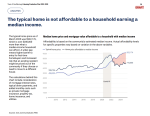 Dating back to 2010, for over a decade, the affordability was higher than the home prices. But in 2022 (post Covid) figures shifted. Now the typical home price in Southborough is now over $200,000 more expensive than what a household earning the Area Median Income (AMI) can afford.2 The “AMI” refers to the region Southborough is included in by HUD (the U.S. Dept of Housing & Urban Development).3
Dating back to 2010, for over a decade, the affordability was higher than the home prices. But in 2022 (post Covid) figures shifted. Now the typical home price in Southborough is now over $200,000 more expensive than what a household earning the Area Median Income (AMI) can afford.2 The “AMI” refers to the region Southborough is included in by HUD (the U.S. Dept of Housing & Urban Development).3
The wider gap means higher barrier to entry for first-time homebuyers and increased risk that an existing resident might be priced out of the community if they choose or need to move to a different house.
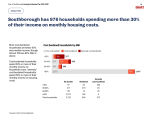 Select Board member Kathy Cook was “shocked” by a figure in the report showing that 976 households (26%) spend are “cost-burdened” by their homes — spending over 30% of their income on housing costs. Looking back at previous HPP’s that isn’t a new situation in our town.
Select Board member Kathy Cook was “shocked” by a figure in the report showing that 976 households (26%) spend are “cost-burdened” by their homes — spending over 30% of their income on housing costs. Looking back at previous HPP’s that isn’t a new situation in our town.
The 2023 stat was the same as the one previously shared for 2017, and was actually down from 30% of households in 2013 and 32% in 2000.
The 2020 report concluded:
The local decline in cost-burdened households is not reflective of a declining regional need for more affordable housing; that need is growing. It simply demonstrates the existence of barriers for low- and middle-income households to access housing in Southborough.
The report also lists 10% of households as “severely cost-burdened”, paying over 50% of income on housing costs. That’s the same as stats shown for 2013 and 2017 (down from 125 in 2000).
In the presentation, Marya claimed that only single family homes had been built since the last plan. That appears to be incorrect. My search of the Town’s online property records found 12 exceptions built from 2020 to 2025 —11 townhouses (2 on Boston Road, 2 on Cain Circle, and 4 on Fayville Lane) and one multi-family (on Main Street). However, that’s much smaller than the 61 single family homes built in that same period.
HPP and Safe Harbor
Currently, the Town has a “safe harbor” certification by the EOHLC (the state’s Executive Office of Housing and Livable Communities). That allows the Zoning Board of Appeals has a discretionary right to reject any new 40B applications (not already in the pipeline) that it doesn’t believe are good for the community.
Without Safe Harbor, under the 40B state law, the board has very little wiggle room to reject an application that is deemed eligible by MassHousing to apply for a comprehensive permit for a dense housing development. (For those unfamiliar, 40B projects don’t have to comply with local zoning laws as long as they meet state requirements. That includes allowing housing developments on land otherwise restricted to commercial/industrial purposes.)
For the Safe Harbor status to continue through the end of 2026, two things need to happen. The building permit for the previously approved 120 Turnpike Rd 40B needs to be pulled by the end of this year. The Town also needs to file an acceptable HPP for 2025 – 2030 showing progress towards meeting its affordable housing goals and a plan for moving forward.
The HPP includes under its goals working to identify the threshold to keep meeting Safe Harbor status in future years.
Other 40B projects currently in the pipeline (250 Turnpike Rd and 352 Turnpike Rd) could add to the SHI (Subsidized Housing Inventory) to help extend the Safe Harbor down the road. Beyond that, the Town would need to look at other ways to meet the metrics. That could include projects funded/co-funded by the AHT, or attracting new 40B projects the town believes is good for the community.
Increasing Housing over next 5 years
For a “healthy” housing market, the 2025 – 2030 HPP recommends adding 255 new homes/housing units over the next 5 years. That’s 84 more than the 171 the HPP shows the town is currently on track to add under current conditions.
Most of the new homes can be “market rate” but 26 should count towards the SHI.
 The plan identifies nine goals:
The plan identifies nine goals:
- Encourage a variety of housing types beyond single-family homes, including townhouses, duplexes, ADUs, and small apartment buildings in contextually appropriate
locations to provide residents with a wider range of housing options for a diversity of life stages and at a range of affordability levels. - Facilitate the development of housing options that are attainable for Southborough residents at different stages of life (e.g., singles, older adults).
- Reinforce Southborough’s economic goals by supporting local businesses through the provision of expanded housing choices that serve a diverse local workforce.
- Support the design of housing development that is compatible with and complementary to the Town’s architectural character and wooded landscapes, while minimizing
impacts of new development on priority areas for open space, conservation, and natural resource protection purposes. - Maintain and improve the condition of the Town’s housing stock, while preserving its stock of naturally-occurring affordable housing.
- Assist Southborough residents to obtain and maintain housing they can afford.
- Enhance local capacity to advocate for, plan, develop, and manage affordable housing.
- Maintain 40B Safe Harbor through the provision of affordable housing units equal to 10% of all units.
- Invest in infrastructure to facilitate the development of housing in priority areas
To work towards meeting those goals, the plan recommends the following strategies:
- ADUs (Use State ADU legalization to add small-unit capacity for flexible, young, and/or aging households)
- MBTA Communities (Utilize the new overlay zoning districts to meet demand)
- Removal of older-adult housing cap (Remove or increase the unit cap in the Town bylaws)
- (Re)development of Route 9 underutilized sites (Identify opportunities for housing development along the highway)
- Wastewater capacity along Route 9 (pursue adding the utility)
- Right-sized zoning near transit and downtown (rezone clusters of smaller parcels to better allow by-right residential development)
- Success tracking – zoning and policy changes
- Preservation of “naturally occurring” affordable housing (use AHT funds, incentives, and/or restrictions to keep older/smaller homes from being replaced with pricier housing)
- Leveraging State funding by pursuing Housing Choice designation
Zoning Proposal to lift/remove Senior Housing Cap
The presentation highlighted that the Town bylaws include a cap on the number of units allowed for elderly housing units:
The total cumulative number of units approved. . . shall at no time exceed 7% of the total number of one-family houses in Southborough at the beginning of the year in which the application is filed, based on the Assessor’s records. Residences containing apartments shall be counted as one-family houses for the purposes of this subsection.
That cap is currently 208 units, with 203 already permitted/built. AHT members prposed lifting the cap to encourage new projects that allow seniors to dowsize in town. (Though not specified in the meeting, the bylaw for the special permit for age 55+ housing projects allows denser development than available through permits for non-age restricted projects.)
Planning member Marnie Hoolahan expressed support, but wondered why the cap had been created. Chair Meme Luttrell believed it was based on residents’ worry that the town would otherwise become a “retirement community”. Member Lisa Braccio worried about the impact of lifting the cap without incorporating other changes for affordability. She pointed out that the permit has been used to create high priced retirement housing.
The Chair agreed with Braccio’s concerns. Luttrell noted that the bylaw included provisions that had been intended to encourage affordable senior housing. That initially included language limiting ownership to a “public or non-profit community housing organization”. The bylaw was revised after the court informed Town Counsel that zoning laws can regulate use but not ownership.
The current bylaw includes the discretionary requirement:
Evidence shall be shown that, to the greatest extent possible, the development is offering to provide for the needs of Southborough residents of varying economic levels.
Member Debbie DeMuria was also supportive but noted that some people see the 55+ housing as “exclusionary zoning”. She wondered about families with children. Marya agreed, but followed that the plan also advocates other strategies for a mix of housing types beyond single-family homes (duplexes, smaller apartment buildings, townhouses) to accommodate everyone.
Luttrell supported working with members of the AHT to come up with bylaw changes. She did note that getting them approved for this Fall’s Special Town Meeting might be too ambitious. If they don’t make that deadline, it could be pushed to Annual Town Meeting in the spring.
Town Planner Karina Quinn noted that age restrictions on truly affordable (deed-restricted) units are not allowed by EOHLC. Luttrell responded that they could still try to include affordability, the resulting units just wouldn’t qualify to be included in the SHI count.
Additional Zoning changes that may be explored in the future
The strategy list included some zoning changes the Planning Board didn’t discuss. That included changes near transit and downtown to “right-size” zoning for clusters of small residential parcels. The plan explains:
There are 156 properties within a half-mile of Southborough’s train station that do not meet minimum lot size requirements of their current zoning (RA or RB). Additionally, there are 87 parcels within a half-mile of Turnpike Road that are too small, per existing zoning, for by-right residential development. Many of them have existing residential uses, but could not be rebuilt as-is under current zoning. The Town should consider rezoning clusters of smaller parcels near transit, downtown, and Turnpike Road, to facilitate production of more attainable, right-sized units. The Town could reassign these clusters of too-small parcels in RA to a more permissive zone, or adjust the minimum lot size requirements overall. Allowing for right-sized housing production on smaller lots could help the Town meet demand among growing young adult and senior populations looking for “starter homes” or downsizer-friendly homes.
And not listed as a recommendation, but included for evaluation, was “Evaluate sites for a 40R district near the train station“. The zoning overlay would allow “dense housing and mixed use development” with a requirement for 20% of the district be affordable homes. The benefit the report cites is incentive payments to the Town from the state. Luttrell called that concept a “third rail” not likely to happen. She and Braccio pointed to the public outcry from the southside of town when the Planning Board discussed the MBTA Communities zoning. They didn’t think it was fair to put too much on the one area of town.
Despite the wording in the plan, AHT board member Doug Manz told the board that the 40R consideration wasn’t focused on adding housing by the train station. He said they were thinking about leveraging state funds for housing and also thinking about areas around Route 9. In another part of the discussion, Manz and Marya clarified that they understand that the Town wants to attract commercial businesses to Route 9. They view the housing as supplementary, envisioning mixed use.
Luttrell suggested the board look at an alternative to 40R zoning that she thought might be more digestible for voters. She appeared to be referring to the state’s new 40Y “starter homes” zoning program. That is written to financially incentivize towns to create zoning overlays that encourage building of “smaller, more compact, and modestly priced single-family homes”.
You can read the full draft of the HPP here. There were a couple of mistakes in the report that Luttrell flagged to be fixed. However, the motion to approve didn’t refer to making the edits first. (I already included one of the edits in the image with the production goal graph. The other was to the page that identified underutilized parcels on Route 9.)
Updated (7/28/25 1:29 pm): I reached out to Town officials to get some more clarity on details in and related to the HPP. I inserted what I learned (mostly from Ellen Marya.) That included an explanation of Southborough’s “Area” for Area Median Income, the timing of the Cost-Burdened data (2023), and the fact that the HPP is being corrected and edited before it is filed by the AHT board.
- The CA story begins with stating the plan recommends adding “255 affordable homes” within 5 years. But while the HPP encourages changes to increase affordable and diverse housing stock, of the additional 255 homes recommended as needed for a “healthy” market only 26 of those are specified as needing to qualify for inclusion in the Subsidized Housing Inventory (SHI). And even the 26 don’t all need to be “affordable”. (For 40B projects with rental units, all of the units are counted in SHI, not just the 10% that qualify as affordable.) The story ends, “With the draft plan now accepted, it next heads to Town Meeting.” That’s incorrect. But, if the Planning Board comes up with zoning changes as a result of the plan, those will be brought to Town Meeting. Plus, the CA story may give readers the impression that Braccio spoke against adding too much senior housing. Her comments focused on fear that lifting/removing the senior housing cap without making other changes to criteria could lead to building a lot of pricey retirement housing, without adding affordable options for Southborough seniors to downsize.
- The chart shows that the “typical home price” in town is $922,176 while the price “affordable to median income” for our area is $710,000. A note explains ” The calculations behind this chart include consideration of mortgage interest rates, typical down payments, and added monthly costs such as private mortgage Insurance, property tax, home insurance, and utilities.”
- AHT board member Ellen Marya explained to me that it Southborough’s “Area” is the Eastern Worcester County HUD Metro FMR Area which includes the towns of Berlin, Blackstone, Bolton, Harvard, Hopedale, Lancaster, Mendon, Milford, Millville, and Upton.

